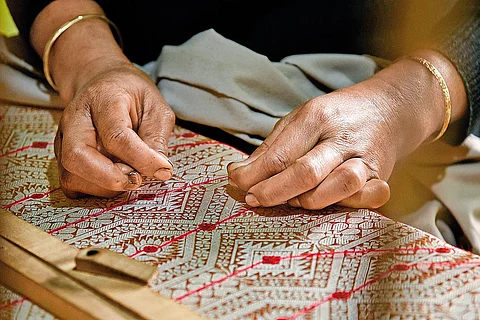
- Destinations
- Experiences
- Stay
- What's new
- Editor’s Picks
- Responsible Tourism
- CampaignsCampaigns
- Subscribe

The biodiversity hotspot of Assam is home to a curious silkworm that founded a textile heritage as far back as 321 BCE. Its creations spawned an industry alluded to in the pages of the Ramayana, where travelling east took you through “the country of cocoon rearers,” and the accounts of French traveller Jean-Baptiste Tavernier from 1662.
This is none other than Antheraea assamensis, known as the Muga silkworm in larval form and the Assam silk moth as an adult. Munching on the leaves of the som, sualu, and mejankari plants, the green larvae produces a natural golden-yellow fibre that is of high durability and a shimmering glossy texture—Muga silk, a cloth so renowned that it graced the closets of Ahom royalty and was reserved for them alone. Royal houses supervised rajagharia looms where state-appointed experts weaved luxurious silks. Chanakya, a scholar of the Mauryan court, described the surface of Muga silk to be as smooth as the surface of a gem in his manuscript. However, this thriving industry entered a period of decline with British expansion and the colonisation of Assam.
Today, the garment has widespread appeal. Due to its protective quality against ultraviolet light, Muga silk umbrellas register a high demand and are exported to various places around the world. That’s not all—in a 2023 book by Elsevier titled “Advanced Materials from Recycled Waste,” researchers Manasi Buzar Baruah and Pranjal Kalita wrote that Muga silk was a “competent candidate for biomaterials, medicines, food and food supplements, and biofuel synthesis” due to its “outstanding quality like biocompatibility, biodegradability, renewability, inexpensive, non-toxicity, UV-resistant, and moisture-friendly behaviour.”
To see Muga silk production in action, you will have to travel to Sualkuchi village, also known as the “Manchester of the East.” Here, men and women produce Pat, Eri and Muga silks, following in a long line of weavers who were brought to this place in the 11th century under the patronage of Ahom kings.
For Kajori Rajkhowa, the head of the Directorate of Sericulture in the Assam government, Muga silk’s association with the state is a point of pride. She cites the example of Hemoprova Chutia, a handloom weaver who was awarded India’s Padma Shri in 2023 for her unique creations.
“Since time immemorial, Muga silk rearing and weaving has been the largest and oldest rural-based household industry in Assam, along with Eri silk. It is almost a family heirloom for us,” she says.
Rajkhowa has noticed demand for this natural fibre rise due to its eco-friendly quality. But the changing climate and the lack of an organised marketing facility, among a host of reasons, threatens the viability of Muga silk production.
The state government is doing what it can to combat these issues, such as installing silkworm plants; conducting genetic studies of Muga silk with the Assam Agricultural University and other relevant stakeholders; promoting silkworm plantations with local representatives on the back of the Indian government’s grant of a Geographical Indication tag for Muga silk; proposing Muga crop insurance schemes and subsidies of Muga seeds for farmers; and setting up a Golden Silk Park and commercial hub in Guwahati—all to spur the textile onto greater heights.
